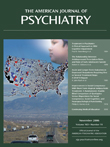The Relationship Between Antidepressant Prescription Rates and Rate of Early Adolescent Suicide
Abstract
Objective: In 2002, 264 children and adolescents ages 5–14 died by suicide in the United States, the fifth leading cause of death. Of these suicides, 260 were in the 10–14 year age group, making suicide the third largest cause of death behind accidents and malignancy. Although 60% of suicides in the general population occur in the midst of a mood disorder, usually untreated, little is known about the relationship between treatment of mood disorders and youth suicide. The FDA recently linked adverse event reports of suicidal ideation among children and adolescents in randomized controlled trials to selective serotonin reuptake inhibitors (SSRIs) and consequently required a change in labeling that included a black box warning regarding SSRI use for all age groups. Given that the age-adjusted suicide rate is about six times higher in 15–19 year olds compared with 10–14 year olds, the risk-benefit ratio may be different in younger children. Therefore, this study examined the association between antidepressant medication prescription rate and suicide rate in children ages 5–14 prior to the FDA findings by analyzing associations at the county level across the United States. Method: National county-level suicide rate data among children ages 5–14 were broken down by sex, income, and race during the period 1996–1998. National county-level antidepressant prescription rate data were expressed as number of pills prescribed per person. The primary outcome measure was the suicide rate in each county expressed as number of suicides for a given population size. Results: After adjustment for sex, race, income, access to mental health care, and county-to-county variability in suicide rates, higher SSRI prescription rates were associated with lower suicide rates in children and adolescents. Conclusions: The aggregate nature of these observational data precludes a direct causal interpretation of the results. More SSRI prescriptions are associated with lower suicide rates in children and may reflect antidepressant efficacy, treatment compliance, better quality mental health care, and low toxicity in the event of a suicide attempt by overdose.



